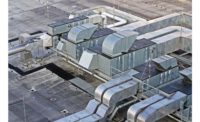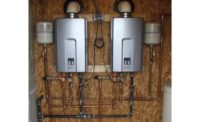Jack DiEnna, Jr. is on a mission.
As the head of Geothermal National and International Initiative Inc. (GEO-NII), he summarizes this mission as “The Road to 30%,” a goal of deploying enough new and upgraded geothermal equipment to save an equivalent of 30 percent of the country’s current electricity usage.
Eight states so far have taken a specific step that encourages greater and faster adoption of geothermal in residential settings: they have formally recognized the ground loop as a renewable thermal asset. This step opens the door to a utility (whether electric or gas) actually owning a home’s ground loop, easing greater adoption by homeowners and officially expanding the utilities energy storage portfolio.
Which states? The Northeast and Rocky Mountain states dominate the list: New York, Maryland, New Hampshire, Vermont, Rhode Island, Massachusetts, Utah, and Colorado.
But how would greater geothermal presence work, and what would it mean for HVAC contractors?
TRICKLE-DOWN OPPORTUNITIES
The consequences and opportunities here for contractors stem from the new consequences and opportunities for homeowners.
“The designation of a ground loop as a qualified DER would assist in deferring or avoiding utility investments in distribution equipment and infrastructure by providing ‘contracted’ services to the end user (heating and cooling) through utility-owned assets,” DiEnna said.
That “contracted services” model represents a significant change from how homeowners, utilities, and contractors are used to thinking about energy — or even about previous geothermal propositions.
DiEnna characterizes a typical ground source heat pump (GHP) project as costing between $10,000 and $40,000 to install, with cost per ton depending on the part of the country, and with an upside of reducing the owner’s HVAC and water heating costs by up to 40 percent. Secondary benefits include longevity, with a ground loop guaranteed for 50 years (and likely to last 100), and a heat pump that ASHRAE estimates is good for 24 years.
But today, companies like Dandelion offer a new pair of options. DiEnna describes one such scenario as an “all in” homeowner tab of between $11,000 and $20,000 after all available rebates and tax incentives.
“Or,” he continued, “the customer can pay nothing up front and pay a monthly fee of $80 to $140 over 20 years.”
In a society where monthly subscription and streaming services have only become more popular along with environmental consciousness, this sort of option may be arising at the right time.
In that model, DiEnna said, a vendor like Dandelion (or Morrison in Pennsylvania, he added) will employ local drillers and installers and will also provide a service agreement for the customer.
TAPPING INTO POTENTIAL
Speaking of local installers, one can’t just pick up a heavy piece of equipment and dig in. The talent pool varies state by state, according to Lisa Meline, P.E., owner and principal engineer for Meline Engineering in Sacramento, California. Meline’s firm specializes in geoexchange, and she is a past chair for the ASHRAE committee on geothermal heat pumps and energy recovery applications.
“In most of the Midwest and South, there are larger talent bases than in California and the Northeast,” she said.
Combine that assessment with the potential for broader geothermal use in regions like the Northeast (see sidebar), and it becomes clear that the current drilling or installing base has not aligned itself geographically with the areas of greatest opportunity.
Locales along the ocean present an extra variable in favor of geothermal, Meline said.
“Coastal regions where salt air quickly ravages outdoor equipment — this is another opportunity for geothermal heat pumps, where the ‘outdoor’ equipment is buried beneath the earth.”
Contractors may find themselves in a territory that is ripe for more geothermal but which is perhaps underserved in terms of qualified professionals. This is where training becomes critical, both for the contractor and the geothermal industry in general.
DiEnna pointed to International Ground Source Heat Pump Association (IGSHPA)-designed curricula “for every trade or profession” in the chain, from residential designers and commercial designers to installers, loopers, drillers, and inspectors. He pointed to the installers’ course as the main pathway: a three-day course for HVAC professionals, taught by IGSHPA trainers.
Meline also recommended the IGSHPA geothermal installer accreditation course. Taught via HeatSpring, one 10-module option for contractors appears available online for $995, offering rolling admission that allows for an immediate start.
Completing courses like that one makes contractors eligible to access certain government incentives. Some product distributors, according to the course description, may require that certification for dealers. Engineers may also use that standing to filter or restrict bid lists to maintain a standard of work.
For those interested in earning advanced designations on the drilling side, Meline mentioned a geothermal driller certification from the National Ground Water Association.
As with so much of HVAC contracting, training and quality installation are paramount.
In DiEnna’s view, “The problems that have always come up are installations by untrained individuals who are only satisfying the customer’s request. There have been instances that I have been involved with of installers designing the system with no knowledge of what is needed in the ground and depending on the auxiliary heating to compensate for that deficiency.”
That, he concluded, causes not only the rude surprise of large heating bills for homeowners but the erroneous perception that GHPs do not work well in general.
GROUNDSWELL OF PRESSURE FOR RENEWABLE ENERGY
It might surprise some to recall that California is not among those eight states that view ground loops as renewable thermal assets. That doesn’t mean that the state, like others, isn’t looking for relief from its current energy situation.
“My understanding is that southern California gas companies do not have sufficient distribution to support their customers; thus, the creation of storage stations,” said Meline. “With the catastrophe at Aliso Canyon, there is a new momentum to eliminate natural gas from buildings.” (For more information on that, visit www.cpuc.ca.gov/aliso.)
The dynamic of utility regulators restricting expansion of natural gas lines should contribute to a friendlier geothermal environment. DiEnna points to states beyond the eight — such as Pennsylvania, Illinois, Texas, and Louisiana — as prime due to individual combinations of factors like recognition of available thermal assets, high utility costs, and current infrastructure.
Oklahoma has the distinction of being the only state to offer a distinct GHP utility rate structure, via CADDO Electric Cooperative.
“The cooperative installs and owns the ground loop and recovers the cost of the loop through a monthly fee built into the customer charge on the utility bill,” DiEnna explained, “and they have quantified a 2.8 kW reduction per residential installation (typically a 4 ton system). The homes on average are experiencing a 40 percent to 70 percent savings on the space conditioning (heating/cooling) and water heating costs, saving from $1,100 to $2,000 annually.”
Another objective is growing not only in California but among states and utilities across the country: the movement to reduce emissions and decarbonize buildings.
“In a decarbonized world, the opportunities to heat and cool homes are either air-source heat pumps or geothermal heat pumps. The former are not nearly as efficient as geothermal
heat pumps in very warm or very cold climates,” Meline said, noting that her state contains 16 climate zones of its own.
DiEnna concludes by citing an Oak Ridge Natural Laboratory study that found that most of the 88.4 million U.S. single-family homes with space conditioning and water heating are good candidates for GHP technology, on account of having a front or back yard that could support loop installation.
It can work in any state, he said, but looks best where that mix develops between strong infrastructure, a reliance on fossil fuel heating, severe weather (which increases the appeal of geothermal’s protected equipment), and restriction on natural gas lines and extensions.
That is assuming, of course, there is an HVAC professional in the area who is qualified to do the job.
Drilling Down on One Geothermal Contractor’s Success
David Leonard is the owner of Evergreen Geothermal, LLC, in Portland, Maine. Evergreen has been installing residential closed-loop systems in southern Maine since 2008 and has built a portfolio of roughly 200 installations.
New England represents a large inventory of homes that have traditionally used heating oil and are now looking for alternatives. It also includes other possible applications like ice rinks, boat storage sheds, and vacation homes with propane backup.
His company delivers a variety of heating and cooling heat pump systems for new homes, retrofits, and light commercial. In addition, Leonard offers consultation services for architects, pre-build design consultation, and radiant floors.
While his home state of Maine has not formally recognized the ground loop as a renewable thermal asset, Leonard offered The ACHR NEWS an overview of several related components and factors that contractors elsewhere might consider. The following is his overview of several aspects of the current environment for geothermal work.
We do design build projects, and we stick very closely to the International Ground Source Heat Pump Association/ACCA/ASHRAE and manufacturer’s recommendations. With the current 30 percent federal tax credit, we are typically pretty competitive cost-wise with conventional systems.
Our system operating costs are typically about half of operating a fossil fuel system in this heating-dominant climate. We regularly see minus 10°F temperatures here during the winter months.
The business is a small niche, but booming — we are booked out for about the next eight months with projects. About 80 percent of what we do are air-type systems, and the rest radiant. We do about 60 percent new construction, 40 percent retrofit. There really isn’t much competition.
We use local drillers regularly, and the key to economical systems is sizing them appropriately, not oversizing (just like the rest of HVAC design), and controlling that aspect of the project. Most of our projects are operated using just one borehole, with traditional PE plastic loops and geothermal grout.
The drillers are great. I am a licensed driller, and they drill to our specifications. The rules of thumb regarding depth per ton for drilling typically are not applicable to our high water table and dense rock environment/heating dominant climate. Those “rules” tend to push the project costs much higher than they need to be, and excessive drilling costs can kill the viability of these projects. By controlling the design ourselves, we are able to offer economically viable projects with regard to conventional systems.
The current tax credit more than offsets the drilling costs, making our systems about the same end price to the homeowner.
That said, in 2016, when there was no tax credit, we had a pretty great sales year, indicating to me that the technology can stand on its own as cost effective.
Building a well-engineered zoned HVAC system and using closed loops, we are able to offer fixed-cost contracts with no cost overruns. We sell a lot of humidifiers, air purifiers, ERV and HRV add-ons to the systems.
The building contractors love having a vendor who can give them a well-operating system and keep their customers happy. We regularly market direct to the homeowner, then end up doing multiple follow-on jobs for their contractors. The contractors all enjoy being able to offer this technology. We get regular repeat orders once they experience a well-engineered and well-installed geothermal system’s comfort, reliability, and performance. The business seems to be growing nicely.
See more articles from this issue here!








